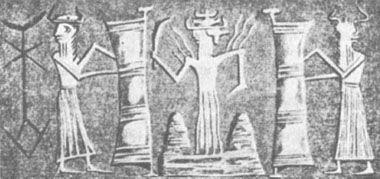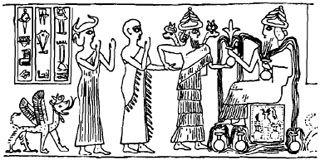The 12th Planet (51 page)
Authors: Zecharia Sitchin
Tags: #Non-Fiction, #Gnostic Dementia, #Fringe Science, #Retail, #Archaeology, #Ancient Aliens, #History

Of the four mighty rivers of Africa, one, the Nile, flows north into the Mediterranean; the Congo and Niger empty into the Atlantic Ocean on the west; and the Zambezi flows from the heartland of Africa in an eastward semicircle until it reaches the east coast. It offers a wide delta with good port sites; it is navigable inland over a distance of hundreds of miles.
Was the Zambezi the "River of Fishes and Birds" of the Lower World? Were its majestic Victoria Falls the waterfalls mentioned in one text as the site of Ereshkigal's capital?
Aware that many "newly discovered" and promising mining sites in southern Africa had been mining sites in antiquity, the Anglo-American Corporation called in teams of archaeologists to examine the sites before modern earth-moving equipment swept away all traces of ancient work. Reporting on their findings in the magazine
Optima,
Adrian Boshier and Peter Beaumont stated that they had come upon layers upon layers of ancient and prehistoric mining activities and human remains. Carbon dating at Yale University and at the University of Groningen (Holland) established the age of the artifacts as ranging from a plausible 2000
B.C.
to an amazing 7690
B.C.
Intrigued by the unexpected antiquity of the finds, the team extended its area of search. At the base of a cliff face on the precipitous western slopes of Lion Peak, a five-ton slab of hematite stone blocked access to a cavern. Charcoal remains dated the mining operations within the cavern at 20,000 to 26,000
B.C.
Was mining for metals possible during the Old Stone Age? Incredulous, the scholars dug a shaft at a point where, apparently, the ancient miners had begun their operations. A charcoal sample found there was sent to the Groningen laboratory. The result was a dating of 41,250
B.C.
, give or take 1,600 years!
South African scientists then probed prehistoric mine sites in southern Swaziland. Within the uncovered mine caverns, they found twigs, leaves, and grass, even feathers—all, presumably, brought in by the ancient miners as bedding. At the 35,000
B.C.
level, they found notched bones, which "indicate man's ability to count at that remote period." Other remains advanced the age of the artifacts to about 50,000
B.C.
Believing that the "true age of the onset of mining in Swaziland is more likely to be in the order of 70,000–80,000
B.C.
, the two scientists suggested that "southern Africa ... could well have been in the forefront of technological invention and innovation during much of the period subsequent to 100,000
B.C.
"
Commenting on the discoveries, Dr. Kenneth Oakley, former head anthropologist of the Natural History Museum in London, saw quite a different significance to the finds. "It throws important light on the origins of Man ... it is now possible that southern Africa was the evolutionary home of Man," the "birthplace" of
Homo sapiens.
As we shall show, it was indeed there that modern Man appeared on Earth, through a chain of events triggered by the gods' search for metals.
•
Both serious scientists and science-fiction writers have suggested that a good reason for us to establish settlements on other planets or asteroids might be the availability of rare minerals on those celestial bodies, minerals that might be too scarce or too costly to mine on Earth. Could this have been the Nefilim's purpose in colonizing Earth?
Modern scholars divide Man's activities on Earth into the Stone Age, Bronze Age, Iron Age, and so on; in ancient times, however, the Greek poet Hesiod, for example, listed five ages—Golden, Silver, Bronze, Heroic, and Iron. Except for the Heroic Age, all ancient traditions accepted the sequence of gold–silver–copper–iron. The prophet Daniel had a vision in which he saw "a great image" with a head of fine gold, breast and arms of silver, belly of brass, legs of iron, and extremities, or feet, of clay.
Myth and folklore abound with hazy memories of a Golden Age, mostly associated with the time when gods roamed Earth, followed by a Silver Age, and then the ages when gods and men shared Earth—the Age of Heroes, of Copper, Bronze, and Iron. Are these legends in fact vague recollections of actual events on Earth?
Gold, silver, and copper are all native elements of the gold group. They fall into the same family in the periodic classification by atomic weight and number; they have similar crystallographic, chemical, and physical properties—all are soft, malleable, and ductile. Of all known elements, these are the best conductors of heat and electricity.
Of the three, gold is the most durable, virtually indestructible. Though best known for its use as money and in jewelry or fine artifacts, it is almost invaluable in the electronics industry. A sophisticated society requires gold for microelectronic assemblies, guidance circuitry, and computer "brains."
Man's infatuation with gold is traceable to the beginnings of his civilization and religion—to his contacts with the ancient gods. The gods of Sumer required that they be served food from golden trays, water and wine from golden vessels, that they be clad in golden garments. Though the Israelites left Egypt in such a hurry that there was no time for them to let their bread leaven, they were ordered to ask the Egyptians for all available silver and gold objects. This command, as we shall find out later, anticipated the need for such materials to construct the Tabernacle and its electronic accoutrements.
Gold, which we call the royal metal, was in fact the metal of the gods. Speaking to the prophet Haggai, the Lord made it clear, in connection with his return to judge the nations: "The silver is mine and the gold is mine."
The evidence suggests that Man's own infatuation with these metals has its roots in the great need of the Nefilim for gold. The Nefilim, it appears, came to Earth for gold and its related metals. They may also have come for other rare metals—such as platinum (abundant in southern Africa), which can power fuel cells in an extraordinary manner. And the possibility should not be ruled out that they came to Earth for sources of radioactive minerals, such as uranium or cobalt the Lower World's "blue stones that cause ill," which some texts mention. Many depictions show Ea—as the God of Mining—emitting such powerful rays as he exits from a mine that the gods attending him have to use screening shields; in all these depictions, Ea is shown holding a miner's rock saw. (Fig. 146)
Though Enki was in charge of the first landing party and the development of the Abzu, credit for what was accomplished—as the case should be with all generals—should not go to him alone. Those who actually did the work, day in, day out, were the lesser members of the landing party, the Anunnaki.
A Sumerian text describes the construction of Enlil's center in Nippur. "The Annuna, gods of heaven and earth, are working. The axe and the carrying-basket, with which they laid foundation of the cities, in their hands they held."
The ancient texts described the Anunnaki as the rank-and-file gods who had been involved in the settlement of Earth—the gods "who performed the tasks." The Babylonian "Epic of Creation" credited Marduk with giving the Anunnaki their assignments. (The Sumerian original, we can safely assume, named Enlil as the god who commanded these astronauts.)

Fig. 146
Assigned to Anu, to heed his instructions,
Three hundred in the heavens he stationed as a guard;
the ways of Earth to define from the Heaven;
And on Earth,
Six hundred he made reside.
After he all their instructions had ordered,
to the Anunnaki of Heaven and of Earth
he allotted their assignments.
The texts reveal that three hundred of them—the "Anunnaki of Heaven," or Igigi—were true astronauts who stayed aboard the spacecraft without actually landing on Earth. Orbiting Earth, these spacecraft launched and received the shuttlecraft to and from Earth.
As chief of the "Eagles," Shamash was a welcome and heroic guest aboard the "mighty great chamber in heaven" of the Igigi. A "Hymn to Shamash" describes how the Igigi observed Shamash approaching in his shuttlecraft:
At thy appearances, all the princes are glad;
All the Igigi rejoice over thee....
In the brilliance of thy light, their path.
They constantly look for thy radiance.
Opened wide is the doorway, entirely.
The bread offerings of all the Igigi [await thee].
Staying aloft, the Igigi were apparently never encountered by Mankind. Several texts say that they were "too high up for Mankind," as a consequence of which "they were not concerned with the people." The Anunnaki, on the other hand, who landed and stayed on Earth, were known and revered by Mankind. The texts that state that "the Anunnaki of Heaven ... are 300" also state that "the Anunnaki of Earth ... are 600."
Still, many texts persist in referring to the Anunnaki as the "fifty great princes." A common spelling of their name in Akkadian,
An-nun-na-ki,
readily yields the meaning "the fifty who went from Heaven to Earth." Is there a way to bridge the seeming contradiction?
We recall the text relating how Marduk rushed to his father Ea to report the loss of a spacecraft carrying "the Anunnaki who are fifty" as it passed near Saturn. An exorcism text from the time of the third dynasty of Ur speaks of the
anunna eridu ninnubi
("the fifty Anunnaki of the city Eridu"). This strongly suggests that the group of Nefilim who founded Eridu under the command of Enki numbered fifty. Could it be that fifty was the number of Nefilim in each landing party?
It is, we believe, quite conceivable that the Nefilim arrived on Earth in groups of fifty. As the visits to Earth became regular, coinciding with the opportune launching times from the Twelfth Planet, more Nefilim would arrive. Each time, some of the earlier arrivals would ascend in an Earth module and rejoin the spaceship for a trip home. But, each time, more Nefilim would stay on Earth, and the number of Twelfth Planet astronauts who stayed to colonize Earth grew from the initial landing party of fifty to the "600 who on Earth settled."
•
How did the Nefilim expect to achieve their mission—to mine on Earth its desired minerals, and ship the ingots back to the Twelfth Planet—with such a small number of hands?
Undoubtedly, they relied on their scientific knowledge. It was there that Enki's full value becomes clear—the reason for his, rather than Enlil's, being the first to land, the reason for his assignment to the Abzu.
A famous seal now on exhibit at the Louvre Museum shows Ea with his familiar flowing waters, except that the waters seem to emanate from, or be filtered through, a series of laboratory flasks. (Fig. 147) Such an ancient interpretation of Ea's association with waters raises the possibility that the original hope of the Nefilim was to obtain their minerals from the sea. The oceans' waters do contain vast quantities of gold and other vital minerals, but so greatly diluted that highly sophisticated and cheap techniques are needed to justify such "water mining." It is also known that the sea beds contain immense quantities of minerals in the form of plum-sized nodules—available if only one could reach deep down and scoop them up.

